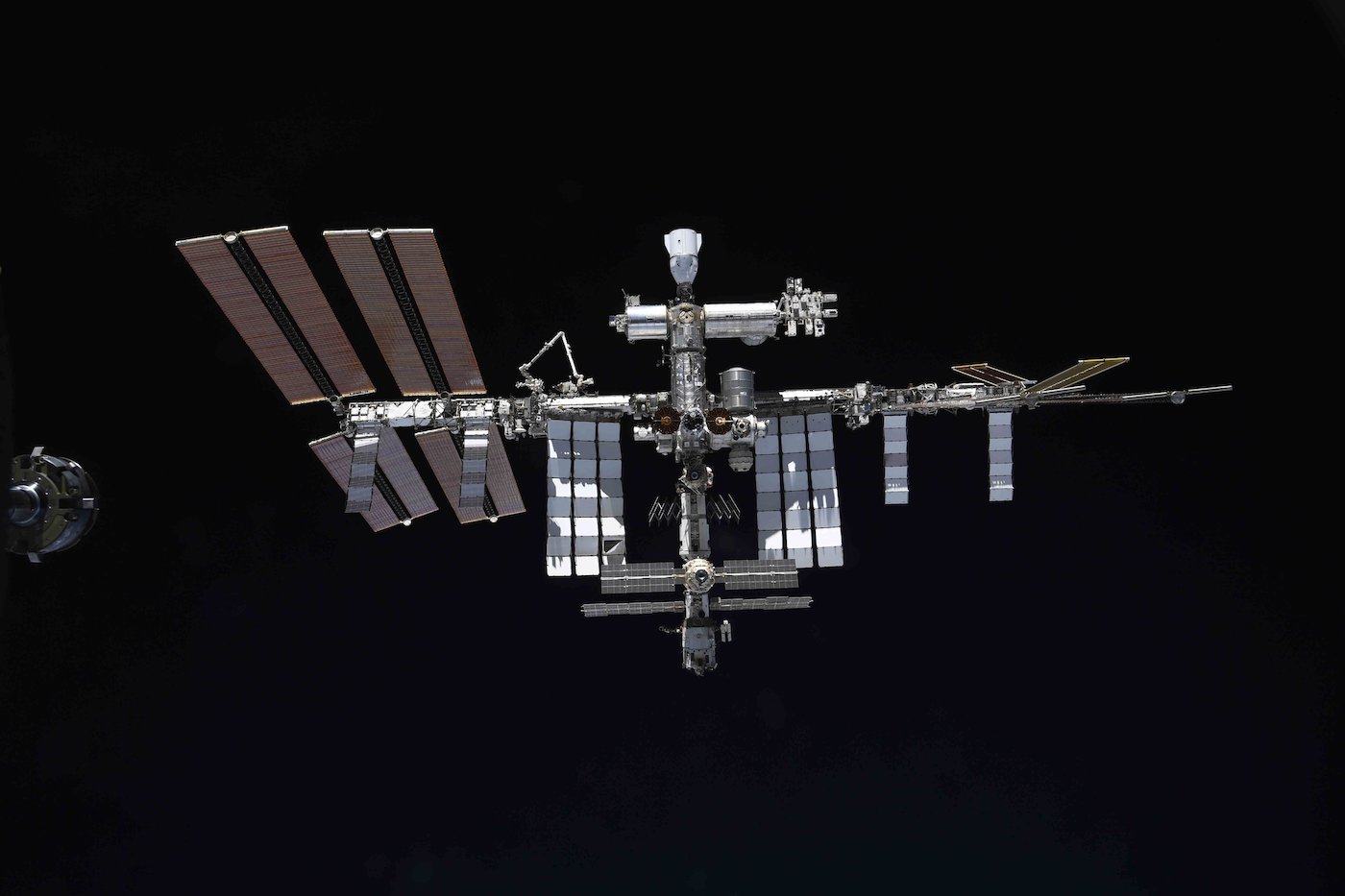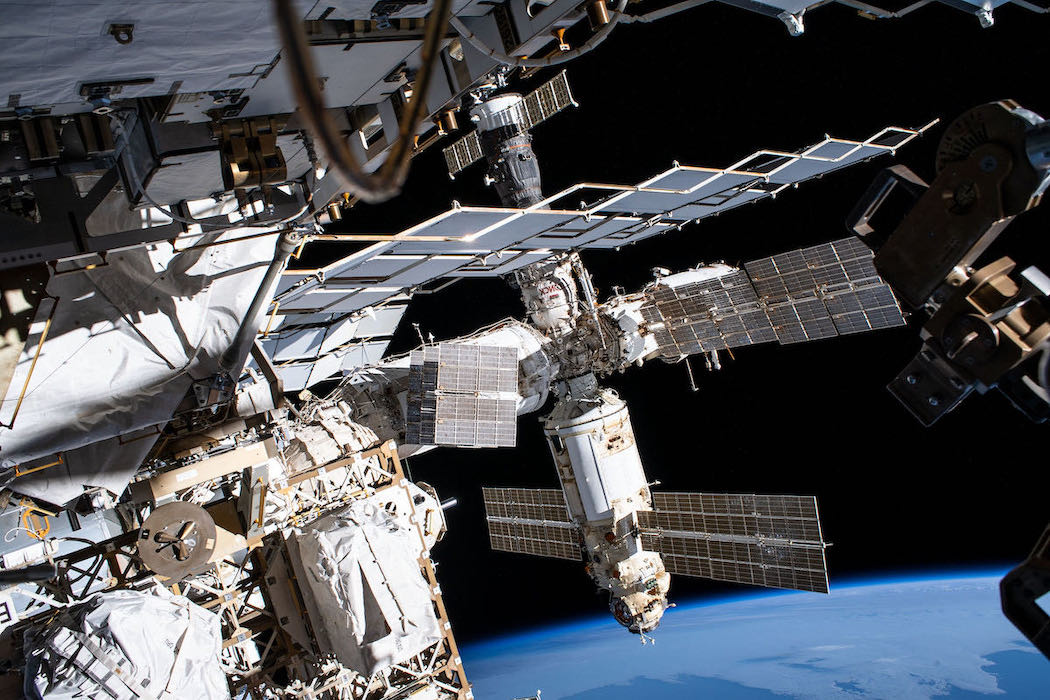Space News & Blog Articles
U.S. officials: Space station at risk from ‘reckless’ Russian anti-satellite test
 A view of the International Space Station captured Sept. 28 by a cosmonaut on the Soyuz MS-18 spacecraft. Credit: Roscosmos
A view of the International Space Station captured Sept. 28 by a cosmonaut on the Soyuz MS-18 spacecraft. Credit: Roscosmos
Russia shot down an old Soviet-era military spacecraft Monday in a test of an anti-satellite weapon, scattering hundreds of thousands of debris fragments that will remain in orbit for years or decades, U.S. government officials said.
The anti-satellite test used a direct-ascent missile, or DA-ASAT, to destroy a decommissioned military surveillance satellite named Cosmos 1408, according to U.S. Space Command.
The military said the test produced more than 1,500 pieces of trackable space debris, and will likely generate hundreds of thousands of pieces of smaller orbital debris. The fragments will remain in orbit for years and potentially for decades, “posing a significant risk to the crew on the International Space Station and other human spaceflight activities, as well as multiple countries’ satellites,” Space Command said in a statement.
The seven-person crew on the International Space Station — four NASA astronauts, two Russian cosmonauts, and a European Space Agency astronaut — took shelter early Monday in their SpaceX Crew Dragon and Russian Soyuz ferry ships.
Mission control directed the crew members to board their lifeboats around 2 a.m. EST (0700 GMT) Monday after orbital tracking data from the U.S. military showed the space station might be at risk from a debris field generated by the anti-satellite test.
The astronauts and cosmonauts remained in their Dragon and Soyuz transport capsules for around two hours. The space station continues to pass through or near the debris cloud every 90 minutes, NASA said, but an assessment performed by teams at NASA’s Johnson Space Center in Houston showed the crew only needed to shelter in their lifeboats for two of the highest-risk passes early Monday.
Mission control also directed the crew to close hatches to radial modules on the station, including the European Columbus and Japanese Kibo laboratories, and the Quest airlock. Hatches between modules along the main axis of the space station remained open, including the door between the U.S. and Russian segments of the space station, according to NASA.
Later Monday, NASA ground teams told the crew that the hatches to the radial modules will remain closed through Tuesday. Mission control canceled planned work with the space station’s robotic arm Monday and told the astronauts to expect significant schedule changes.
The emergency response to the space debris threat came a little more than three days after the four newest crew members — Raja Chari, Tom Marshburn, Matthias Maurer, and Kayla Barron — docked at the space station on their SpaceX Crew Dragon Endurance spacecraft, a day after launching from Kennedy Space Center.
“It’s a crazy way to start a mission,” mission control told the astronauts.
“We’re looking forward to a calmer day tomorrow,” responded astronaut Mark Vande Hei from the space station.
Vande Hei launched to the space station earlier this year on a Russian Soyuz spacecraft, along with cosmonaut Pyotr Dubrov. Cosmonaut Anton Shkaplerov is commander of the seven-person Expedition 66 crew on the space station.
 A view of the Russian segment of the International Space Station. Credit: NASA
A view of the Russian segment of the International Space Station. Credit: NASA
Ned Price, a State Department spokesperson, called the Russian anti-satellite test dangerous, reckless, and irresponsible.
“The long-lived debris created by this dangerous and irresponsible test will now threaten satellites and other space objects that are vital to all nations’ security, economic, and scientific interests for decades to come,” said Secretary of State Antony Blinken. “In addition, it will significantly increase the risk to astronauts and cosmonauts on the International Space Station and other human spaceflight activities. The safety and security of all actors seeking to explore and use outer space for peaceful purposes has been carelessly endangered by this test.”
In a statement, Blinken called on “responsible spacefaring nations” to develop norms of behavior and not conduct destructive anti-satellite tests. He said the test Monday showed that Russia “is willing to jeopardize the long-term sustainability of outer space and imperil the exploration and use of outer space by all nations through its reckless and irresponsible behavior.”
“We have spoken to senior Russian officials multiple times to warn them of the irresponsibility and dangerousness of such a test,” Price said.
“This won’t be tolerated,” Price said. “This is puts our interests, this puts the collective interest of the international community in, in some cases, great danger.”
Price declined to specify what measures the U.S. government and its allies might take against Russia in response to the anti-satellite test.
“We don’t telegraph specific measures, but we will work with our allies and partners in different ways to make clear that the United States and the international community is not going to tolerate this kind of irresponsible behavior.”
Army Gen. James Dickinson, head of Space Command, said debris from the anti-satellite test will force more collision avoidance maneuvers by the space station and other satellites in low Earth orbit.
Russian government officials did not comment on the anti-satellite test. Shkaplerov, the Russian commander of the space station, tweeted Monday: “Friends, everything is regular with us! We continue to work according to the program.”
Cosmos 1408 was orbiting at an altitude of around 300 miles (480 kilometers) before the anti-satellite test, flying in a north-south path around Earth with an inclination of 82.6 degrees to the equator.
The International Space Station flies around 260 miles (420 kilometers) above the planet. China’s space station, with three astronauts currently on-board, orbits a little lower at an average altitude of about 240 miles (385 kilometers).
The energy from the anti-satellite weapon’s high-speed impact with Cosmos 1408 likely thrust some fragments to higher and lower altitudes, scattering debris around the planet.
“The debris cloud will disperse a bit over a period of days, so you will get continuing, but not as intense, risk for the next few years,” wrote Jonathan McDowell, an astrophysicist and respected tracker of spaceflight activity, in response to questions from Spaceflight Now.
Traveling at roughly 5 miles per second, even small pieces of space junk could damage the space station. A debris fragment with the right size and approach angle could pierce hull of one of the space station’s modules, forcing astronauts to seal off a section of the complex.
In a worst case scenario, the astronauts and cosmonauts would evacuate the space station and return to Earth in their Dragon and Soyuz lifeboats
Russia has tested its Nudol anti-satellite missile system from the Plesetsk Cosmodrome more than 10 times since 2014. But the previous test launches did not intercept a satellite in orbit.
China was widely criticized in 2007 when it demonstrated a direct-ascent anti-satellite weapon, launching a missile to intercept a defunct Chinese weather satellite. The kinetic impact created thousands of debris fragments, including nearly 3,400 large enough to be tracked. Half of the debris objects could still be in orbit 20 years after the test, according to orbital debris experts at NASA.
India tested an anti-satellite missile in March 2019, successfully impacting a small Indian satellite in orbit and generating several hundred debris fragments, according to U.S. government officials. The Indian test occurred at a lower altitude, and most of the debris was expected to naturally re-enter the atmosphere.
The United States has twice destroyed a satellite in low Earth orbit with an anti-satellite missile. The U.S. Air Force tested an air-launched anti-satellite weapon in 1985 and hit a U.S. military research satellite.
The U.S. Navy launched a ship-based missile in 2008 to destroy an out-of-control National Reconnaissance Office spy satellite, a decision U.S. officials said was intended to ensure the spacecraft would not pose a public safety threat during re-entry.
This email address is being protected from spambots. You need JavaScript enabled to view it. the author.
Follow Stephen Clark on Twitter: @StephenClark1.
When you subscribe to the SpaceZE News Feed, we will send you an e-mail when there are new updates on the site so you wouldn't miss them.

